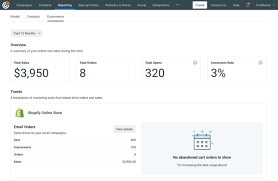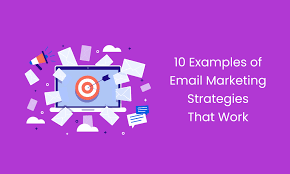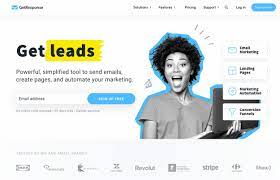Constant Contact Email Marketing: Unlocking the Power of Effective Communication
In today’s fast-paced digital world, effective communication is the key to success for businesses of all sizes. One powerful tool that has revolutionized the way businesses connect with their audience is Constant Contact Email Marketing. With its user-friendly interface and robust features, Constant Contact has become a go-to platform for businesses looking to build strong relationships with their customers through email marketing.
So, what exactly is Constant Contact Email Marketing? Simply put, it is a comprehensive email marketing platform that empowers businesses to create, send, and track professional-looking emails. Whether you are a small business owner, an entrepreneur, or a marketer working for a larger organization, Constant Contact offers a wide range of features to help you effectively engage your audience and achieve your marketing goals.
First and foremost, Constant Contact provides an intuitive drag-and-drop email editor that allows you to effortlessly create visually appealing emails without any coding knowledge. From customizable templates to personalized content blocks, you have the freedom to design emails that align with your brand’s identity and capture the attention of your recipients.
One standout feature of Constant Contact is its robust contact management system. It enables you to easily import and organize your contact lists while providing advanced segmentation options. This means you can tailor your messages based on specific criteria such as demographics, interests, or past interactions. By sending targeted emails to different segments of your audience, you can deliver more relevant content that resonates with each recipient individually.
To ensure maximum deliverability and engagement rates, Constant Contact offers a suite of tools designed to optimize your email campaigns. These include automated welcome emails for new subscribers, A/B testing capabilities to determine the most effective subject lines or content variations, as well as real-time tracking and reporting features. With these insights at your fingertips, you can analyze campaign performance and make data-driven decisions to continually improve your email marketing strategy.
Constant Contact also recognizes the importance of social media integration in today’s digital landscape. With its social media sharing tools, you can easily extend the reach of your emails by posting them directly to your social platforms or encouraging recipients to share your content with their networks. This seamless integration between email marketing and social media allows for a cohesive and consistent brand presence across multiple channels.
Furthermore, Constant Contact goes beyond just email marketing by offering additional features such as event management, surveys, and polls. This versatility allows businesses to engage with their audience beyond traditional email campaigns, creating opportunities for increased interaction and feedback.
In terms of support, Constant Contact provides exceptional customer service with a wealth of resources at your disposal. From live chat support to a comprehensive knowledge base and educational webinars, you can access the guidance you need to make the most of the platform and optimize your email marketing efforts.
In conclusion, Constant Contact Email Marketing is a powerful tool that empowers businesses to effectively communicate with their audience through professional-looking emails. With its user-friendly interface, advanced features, and excellent customer support, it has become a trusted solution for businesses looking to build strong relationships with their customers through targeted email campaigns. Unlock the power of Constant Contact Email Marketing today and take your communication strategy to new heights.
5 Essential Tips for Effective Constant Contact Email Marketing
- Keep your content concise and to the point – readers don’t have time for long emails.
- Include a call-to-action in every email to encourage readers to take action.
- Personalise the emails you send out by using merge tags to include customer names, locations, or other personalised information.
- Test different subject lines and designs to see what works best for your audience.
- Monitor the performance of your campaigns and use data insights to inform future strategies and tactics.
Keep your content concise and to the point – readers don’t have time for long emails.
Mastering the Art of Concise Communication in Constant Contact Email Marketing
In today’s fast-paced world, time is a precious commodity. When it comes to email marketing, keeping your content concise and to the point is crucial. Readers simply don’t have the time or patience for long, wordy emails. That’s where Constant Contact Email Marketing can help you shine by delivering impactful messages efficiently.
One of the key tips for successful email marketing is to focus on brevity while still conveying your message effectively. Start by crafting a clear and attention-grabbing subject line that entices recipients to open your email. Once they do, make every word count.
Begin with a concise introduction that quickly captures their interest and clearly states the purpose of your email. Avoid unnecessary fluff and get straight to the point. Remember, you only have a few seconds to capture their attention before they move on.
When it comes to the body of your email, keep paragraphs short and use bullet points or numbered lists to break up information into easily digestible chunks. This allows readers to scan through your content quickly and find what’s most relevant to them.
Focus on highlighting the key benefits or important details rather than overwhelming readers with excessive information. Use strong and persuasive language that compels them to take action without overwhelming them with lengthy explanations.
Another effective technique is incorporating visuals such as images or infographics that support your message. Visuals can convey information more efficiently than text alone, capturing attention and enhancing understanding in a fraction of the time.
Lastly, end your email with a clear call-to-action (CTA) that guides readers towards taking the desired action. Whether it’s making a purchase, signing up for an event, or simply visiting your website, make sure your CTA stands out and is easily actionable.
By adhering to these principles of concise communication in Constant Contact Email Marketing, you can create emails that grab attention, deliver valuable information swiftly, and prompt readers to engage with your brand. Remember, less is often more when it comes to email marketing. Respect your readers’ time, keep your content focused and impactful, and watch as your engagement rates soar.
Include a call-to-action in every email to encourage readers to take action.
Maximizing the Impact of Your Constant Contact Emails: The Power of the Call-to-Action
When it comes to email marketing, one crucial element often overlooked is the call-to-action (CTA). A well-crafted CTA can be the difference between a passive reader and an engaged customer. In your Constant Contact emails, including a clear and compelling call-to-action is essential to encourage readers to take action.
A call-to-action serves as a guide for your recipients, directing them towards the desired action you want them to take. Whether it’s making a purchase, signing up for a newsletter, downloading a resource, or simply visiting your website, an effective CTA prompts readers to engage further with your brand.
To create an impactful call-to-action in your Constant Contact emails, there are a few key elements to consider. Firstly, clarity is paramount. Make sure your CTA stands out visually and is easy to understand. Use contrasting colors or bold typography to draw attention to it. Keep the text concise and specific so that readers know exactly what they are being asked to do.
Secondly, make your CTA compelling by highlighting the benefits or value readers will gain from taking action. For example, instead of simply saying “Click here,” try using phrases like “Discover exclusive offers” or “Unlock valuable insights.” By emphasizing what’s in it for them, you create a sense of urgency and motivation.
Thirdly, consider placing your CTA strategically within your email. Ideally, it should be visible without requiring excessive scrolling. Position it prominently above the fold or at the end of sections where you’ve provided relevant information that supports the desired action.
Furthermore, personalize your CTAs whenever possible. Tailor them based on recipient segments or their past interactions with your brand. Personalization adds relevance and increases the likelihood of engagement.
Lastly, track and analyze the performance of your CTAs using Constant Contact’s robust tracking features. Monitor click-through rates, conversion rates, and other metrics to gain insights into what resonates with your audience. Experiment with different CTAs and placement to continually optimize your email campaigns.
Remember, the goal of including a call-to-action in every email is to encourage readers to take action. By crafting clear, compelling, and strategically placed CTAs, you can guide your recipients towards the desired outcome and drive meaningful engagement with your brand. So, don’t miss out on this opportunity to make the most of your Constant Contact emails. Start incorporating impactful CTAs today and watch as your email marketing efforts yield greater results.
Personalise the emails you send out by using merge tags to include customer names, locations, or other personalised information.
Personalize Your Email Marketing with Constant Contact’s Merge Tags
When it comes to email marketing, personalization is key. Gone are the days of generic, one-size-fits-all email campaigns. Today, customers expect tailored content that speaks directly to their needs and interests. With Constant Contact’s merge tags feature, you can easily personalize the emails you send out by including customer names, locations, or other personalized information.
Merge tags are placeholders that dynamically pull data from your contact list and insert it into your emails. By simply adding a merge tag in your email template, you can create a more personalized experience for each recipient. For example, instead of starting an email with a generic “Dear Customer,” you can use a merge tag to automatically include the customer’s first name, such as “Dear John.”
This small tweak may seem insignificant, but it can make a world of difference in how your audience perceives your brand. Personalized emails have been proven to increase open rates, click-through rates, and overall engagement. When customers see their name or other personalized information in an email, they feel valued and are more likely to pay attention to the content you’re sharing.
In addition to customer names, merge tags allow you to include other personalized information such as locations or specific details related to their interactions with your business. For example, if you run a clothing store with different branches in various cities, you can use merge tags to mention the nearest store location based on each customer’s address.
To make the most of merge tags in Constant Contact, start by collecting relevant data from your customers during sign-up or through surveys. This could include their names, locations, preferences or any other information that will help you tailor your emails effectively.
Once you have this data stored in your contact list within Constant Contact’s platform, incorporating merge tags into your email templates is straightforward. Simply select the desired merge tag from the options provided and insert it into the appropriate section of your email. When you send out the campaign, Constant Contact will automatically replace the merge tag with the corresponding data for each recipient.
Remember, personalization goes beyond just using someone’s name. Consider segmenting your contact list based on specific criteria and use merge tags to include personalized content that is relevant to each segment. For example, if you have a special offer for customers who recently made a purchase, you can create a segment based on their purchase history and use merge tags to include details of their previous order in your email.
In conclusion, personalization is a powerful tool in email marketing, and Constant Contact’s merge tags feature makes it easy to incorporate personalized information into your campaigns. By utilizing this feature effectively, you can create a more engaging and relevant experience for your audience, leading to higher open rates, click-through rates, and ultimately better results for your business. Take advantage of Constant Contact’s merge tags today and start building stronger connections with your customers through personalized email marketing.
Test different subject lines and designs to see what works best for your audience.
Maximizing Email Engagement: Testing Subject Lines and Designs with Constant Contact
In the world of email marketing, capturing your audience’s attention is crucial. One effective way to optimize your email campaigns and boost engagement is by testing different subject lines and designs. With Constant Contact Email Marketing, you have the power to experiment and discover what resonates best with your audience.
Subject lines act as the gateway to your emails, determining whether recipients open or ignore them. Crafting compelling subject lines that pique curiosity or offer value can significantly impact your open rates. However, what works for one audience may not work for another. That’s where testing comes in.
Constant Contact makes it easy to test different subject lines by providing A/B testing capabilities. This feature allows you to send two variations of an email to a subset of your audience, each with a different subject line. By analyzing the open rates of both versions, you can determine which subject line performs better and use that knowledge to refine future campaigns.
When conducting A/B tests on subject lines, consider experimenting with different approaches. Test variations that include personalization, urgency, or specific keywords relevant to your audience’s interests. Keep in mind that simplicity can sometimes be more effective than complex or lengthy subject lines.
In addition to subject lines, testing different email designs can also make a significant impact on engagement rates. Constant Contact offers a user-friendly drag-and-drop editor that allows you to create visually appealing emails without any coding knowledge.
Start by experimenting with various design elements such as color schemes, font styles, and layout structures. Test different call-to-action buttons or placement options for optimal click-through rates. Remember to keep your designs consistent with your brand identity while ensuring they are visually appealing and easy to navigate.
To conduct A/B tests on email designs, segment your audience into two groups and send each group a different version of the same email content but with distinct visual elements. Analyze metrics such as click-through rates, conversion rates, and overall engagement to determine which design resonates best with your audience.
Testing subject lines and designs is an ongoing process that requires continuous monitoring and analysis. Constant Contact provides real-time tracking and reporting features, allowing you to measure the success of your email campaigns. Use these insights to refine your strategies, adapting them to the preferences and behaviors of your audience.
In conclusion, testing different subject lines and designs is a valuable strategy to optimize your email marketing efforts with Constant Contact. By experimenting with variations and analyzing the results, you can gain valuable insights into what captures your audience’s attention and drives engagement. Embrace the power of testing in order to deliver emails that stand out in crowded inboxes and ultimately achieve better results for your business.
Monitor the performance of your campaigns and use data insights to inform future strategies and tactics.
Monitoring the Performance of Your Constant Contact Email Marketing Campaigns: Harnessing the Power of Data Insights
In the ever-evolving landscape of digital marketing, staying ahead of the curve is crucial for businesses looking to maximize their email marketing efforts. One invaluable tip when using Constant Contact Email Marketing is to monitor the performance of your campaigns and use data insights to inform future strategies and tactics.
Constant Contact provides a range of tracking and reporting features that allow you to gain valuable insights into how your email campaigns are performing. By regularly reviewing these metrics, you can identify trends, understand what resonates with your audience, and make data-driven decisions to optimize your future email marketing strategies.
One key metric to pay attention to is open rates. This tells you how many recipients actually opened your email. A low open rate may indicate that your subject line or preview text needs improvement or that your emails are not reaching the right audience. By analyzing this data, you can experiment with different subject lines or segment your contact list further to increase engagement.
Click-through rates (CTR) are another essential metric to monitor. CTR measures how many recipients clicked on links within your emails. A high CTR indicates that your content is engaging and compelling enough for recipients to take action. Conversely, a low CTR may signal that your calls-to-action need optimization or that you should consider revising the layout and placement of links within your emails.
Conversion rates provide valuable insights into how effective your email campaigns are at driving desired actions, such as making a purchase or filling out a form. By tracking conversions, you can identify areas where you may need to refine your messaging or optimize landing pages for better results.
Furthermore, Constant Contact allows you to compare different versions of an email through A/B testing. This feature enables you to test variations in subject lines, content, or design elements with a subset of recipients before sending out the final version. By analyzing the results of these tests, you can make informed decisions about which elements resonate best with your audience and apply those insights to future campaigns.
It is also essential to track unsubscribe rates and spam complaints. While it can be disheartening to see recipients opting out or marking your emails as spam, it provides valuable feedback about the relevance and quality of your content. By analyzing these metrics, you can identify potential areas for improvement and adjust your email marketing strategies accordingly.
In conclusion, monitoring the performance of your Constant Contact Email Marketing campaigns and using data insights to inform future strategies and tactics is a crucial practice for achieving email marketing success. By regularly reviewing metrics such as open rates, click-through rates, conversion rates, and subscriber feedback, you can gain valuable insights into what works best for your audience. Armed with this knowledge, you can refine your email marketing approach, increase engagement, and ultimately drive better results for your business.



